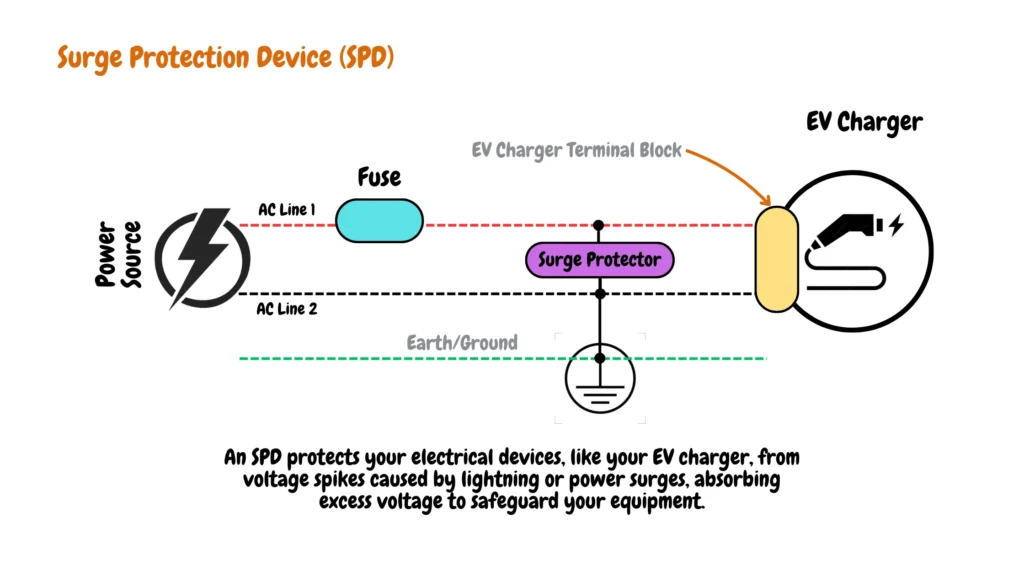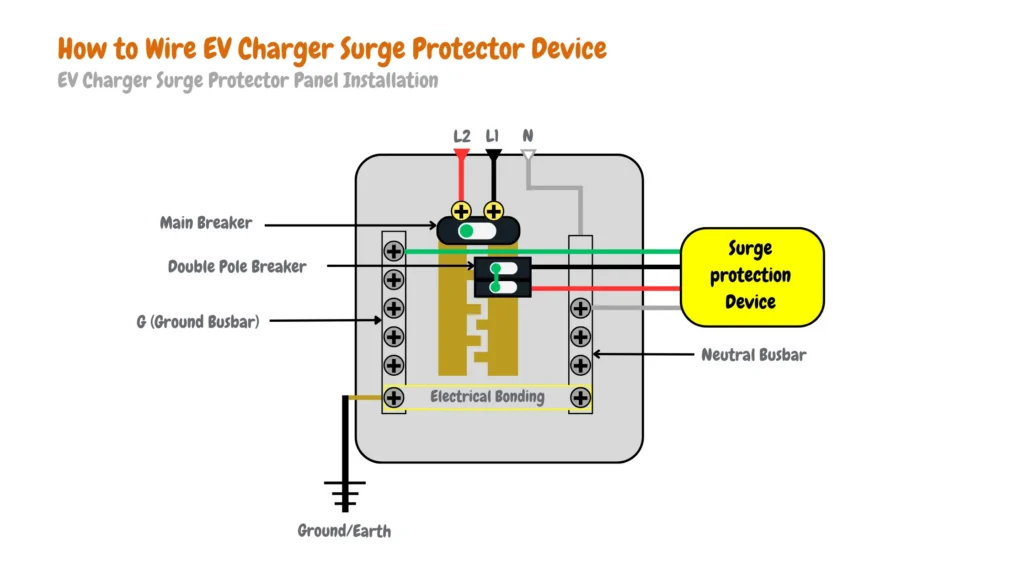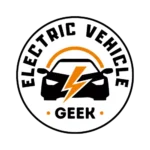EV charger surge protection (SPD) is essential for safeguarding your EV charger installation from high-voltage electrical surges, shocks, and other circuit irregularities
Installing a surge protection device helps protect your EV charger and EV charging accessories by redirecting sudden voltage spikes to ground before they reach sensitive EV charging accessories connected to the EV charger’s branch circuit. This prevents damage, ensures consistent power delivery, and reduces downtime during charging.
Surge protection is especially recommended if your area experiences grid instability or if you have a renewable energy EV charger setup, such as solar EV charging, where voltage levels may fluctuate during transitions between power sources.
Without protection, voltage spikes in the EV charger’s branch circuit can damage the EV charger’s internal circuitry, connected EV charging accessories, and, in extreme cases, the vehicle’s onboard charging system, which mainly features its surge protection measures
A surge protector works by safely diverting excess voltage away from the EV charger and wiring, helping to maintain consistent performance and reliable charging.
Table of Contents
Surge Protection Types for EV Charger Installations (U.S.)
Type 1 Surge Protection Devices (Type 1 SPD)
Type 1 SPDs protect against high-energy surges from external sources, such as direct lightning strikes and utility faults on overhead lines. They are installed at the main service panel or meter base and are required in buildings with overhead service or external lightning protection systems. For EV charging setups in lightning-prone areas or large commercial buildings, Type 1 SPDs provide the first line of defense.
Type 2 Surge Protection Devices (Type 2 SPD)
Type 2 SPDs protect against indirect lightning, grid switching surges, and internal power disturbances. They are installed at a subpanel near the EV charger, such as in a garage or outdoor load center. This is the most appropriate choice for residential and light commercial EV charger installations.
Type 3 Surge Protection Devices (Type 3 SPD)
Type 3 SPDs provide point-of-use protection and are installed directly at the EV charger or outlet. They are often built into the EVSE or used as plug-in surge protectors, offering low let-through voltage. However, Type 3 SPDs are not a standalone solution and must be used in combination with a Type 2 or Type 1 SPD upstream.
Best Surge Protection Types for EV Charger Installations
For home EV chargers, which mainly consist of 120V Level 1 EV chargers and 240V Level 2 EV chargers, whether you’re installing a hardwired EV charger or using a plug-in EV charger, we recommend installing a Type 2 surge protection device (SPD) at the subpanel closest to the EV charger. SPD protects against utility switching surges and indirect lightning strikes.
For commercial or multi-unit EV charger installations, such as Level 3 EV chargers or high amperage Level 2 EV chargers where chargers are fed directly from the main distribution panel, we recommend a Type 1 or combined Type 1/2 SPD. Type 1 units handle direct lightning and high-energy utility faults, which is critical if the building has overhead service or is in a lightning-prone area. A combination unit gives you both upstream and downstream protection in one device.
For extra protection right at the EV charger, we suggest adding a Type 3 SPD at the point of use. Many EV chargers already have Type 3 SPD built in, especially smart Level 2 EV chargers; however, a Type 3 SPD is only effective when used with a properly installed Type 1 or Type 2 SPD upstream.
How EV Charger Surge Protection Works
An EV charger surge protector is installed in the electric vehicle’s branch circuit to safeguard the EV charging equipment and connected accessories from high-voltage surges and electrical irregularities. In the event of a surge, the SPD absorbs and redirects excess energy through the EV charger grounding system, protecting sensitive components such as the EV charger, wiring, and control electronics.

In an electric vehicle branch circuit, EV charger surge protection is mainly installed in your home electrical panel or dedicated EV charger subpanel to protect your whole EV charger installation, as shown in the illustrative image below:

Do EV Chargers Require Surge Protection?
Yes, EV charger installation requires surge protection, for example, a standard Level 1 or Level 2 charger installed in the United States is under 120V/240V, and most electric vehicles can handle 100-400V if power surges beyond that point in an electric vehicle branch circuit it can damage EV charging equipment, EV, and might also cause fires.
Power surges can occur during power outages considering 73.7% of Americans experience power outages, of all major power outages in the United States 80% are due to weather-related outages, and if you live in less weather-related regions like Ohio power outages can be as a result of faulty EV charger wiring during installation, or due to wear and tear leaving them exposed and damaged, aging or fault EV charger installation equipment such as ground cables, and power cables can also lead to power outages in your electric vehicle branch circuit.
It’s not just major power outages; even small, repeated fluctuations in your EV charger installation can damage your consumer unit, wiring, EV charger, and related EV charging accessories through electrical surges known as transient overvoltages.
Transient overvoltages are short bursts of excessive voltage that can occur in an EV charger installation due to the sudden release of stored or induced energy. These electrical surges may result from natural events like lightning or from man-made sources such as switching operations, faulty wiring, or nearby equipment turning on and off.
Why Install EV Charger Surge Protection Devices?
Installing a Surge Protection Device (SPD) in the electric vehicle (EV) branch circuit is crucial for safeguarding against various potential hazards. EV charging stations, whether located outdoors or indoors, are susceptible to lightning strikes. Lightning strikes nearby can induce significant voltage surges, endangering both the charging station equipment and the vehicles connected to it.
Moreover, utilities themselves can unintentionally introduce surges due to switching activities, short outages, or operational malfunctions. These events often result in voltage drops followed by sudden surges, which can damage sensitive electronic components within the charging infrastructure.
Transformers, integral components in electrical distribution systems, are also known to fail occasionally, leading to substantial surges that can propagate through the EV charging system if not intercepted by an SPD. Additionally, inverters commonly employed in conjunction with battery backup or solar systems in renewable EV charging may intermittently cause over-voltage conditions, posing further risks to EV chargers.
By installing an SPD in the EV branch circuit, these potential risks are mitigated. The SPD acts as a protective barrier, rapidly diverting excess voltage away from the charging equipment during surge events. This proactive measure not only enhances the operational reliability of EV charging stations but also extends the lifespan of the equipment, thereby ensuring consistent and safe charging experiences for EV owners.
Best EV Charger Surge Protection Devices.
Before purchasing a surge protection device for your EV charger, it’s crucial to understand the voltage, amperage, and charging loads of your electric vehicle’s branch circuit.
Below is a table detailing common branch circuit specifications for Level 1, Level 2, and Level 3 EV chargers:
| Level 1 EV Charging | Level 2 EV Charging | Level 3 EV Charging |
|---|---|---|
| Single Phase 120V | Single Phase 208 or 240V | Three Phase 208 to 480V |
| 12-16 Amps | 12 to 18 Amps | <125 Amps |
| 1.4 to 1.9 kW Charging Loads | 2.5 to 19.2 kW Charging Loads | <90 kW |
After noting your EV charger installation voltage, amperage, and charging loads, it’s time to narrow down the best EV charger surge protection device for your specific EV charger installation.
Level 1 EV Charger Surge Protector
Level 1 EV charger surge protectors are typically installed at the main AC distribution panel (120/240V service). Level 1 EV chargers operate on 120V AC power and draw 12 to 16 amps, delivering continuous loads of approximately 1.4 to 1.9 kW.
Here are some of the best Level 1 EV charger surge protectors we recommend:
Level 2 EV Charger Surge Protector
Level 2 EV chargers operate on 208V to 240V AC circuits and require appropriate surge protection to prevent damage from voltage spikes. A surge protection device (SPD) should be installed near the point of use, either close to the EV charging outlet for plug-in EV chargers or near the junction box, EV charger pedestal, or EV charger lock box for hardwired EV chargers.
The best Level 2 EV charger surge protector devices we recommend include:
Level 3 EV Charger Surge Protector
Level 3 EV chargers are the most expensive on our list, requiring three-phase 208V to 480V AC input power and delivering the fastest DC fast charging speeds. We recommend installing Level 3 EV charger surge protectors near the point of use, including at the power cabinet and the charging dispenser, to protect critical AC and DC components from high-energy surges.
The best Level 3 EV charger surge protector we recommend includes:
Conclusions.
In conclusion, proper surge protection for EV chargers is essential to safeguard both your vehicle and charging equipment. Whether using Level 1, Level 2, or Level 3 EV charger surge protectors, each offers a different level of protection against voltage spikes that can damage the main panel, EV charger branch circuit, charger, and connected accessories.
Investing in a quality EV charging surge protection device ensures the longevity and reliability of your EV charger installation and gives you peace of mind knowing your investment is protected from electrical hazards.

James Ndungu is a certified EV charger installer with over five years of experience in EVSE selection, permitting, and installation. He holds advanced credentials, including certification from the Electric Vehicle Infrastructure Training Program (EVITP) and specialized training in EV charging equipment and installation, as well as diplomas in EV Technology and Engineering Fundamentals of EVs. Since 2021, James has tested dozens of EV chargers and accessories, sharing expert insights into the latest EV charging technologies.
Last update on 2025-06-30 / Affiliate links / Images from Amazon Product Advertising API













